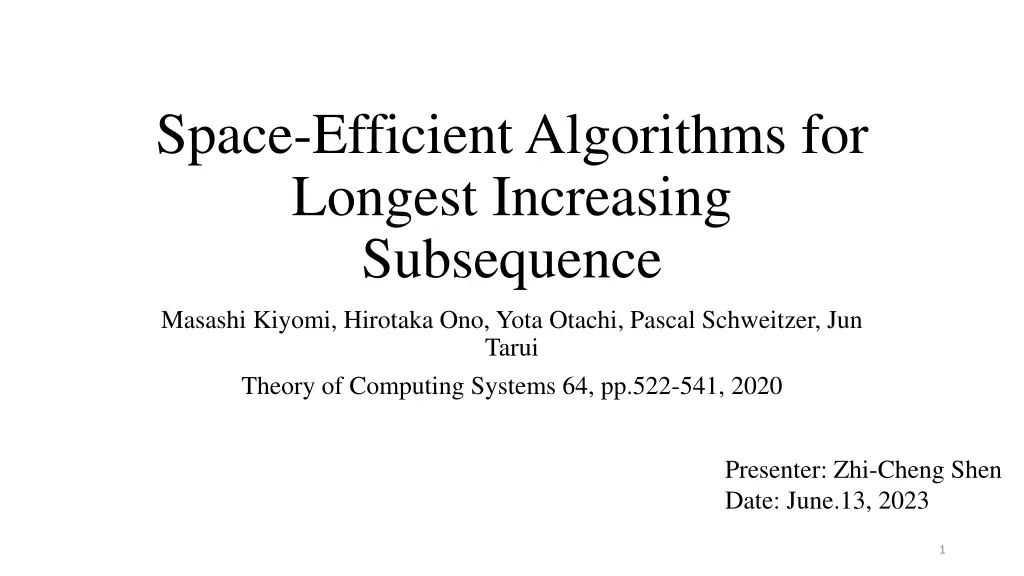
Efficient Algorithms for Longest Increasing Subsequence with Space Optimization
Discover space-efficient algorithms for finding the longest increasing subsequence in a sequence of integers while minimizing space consumption. The paper introduces efficient algorithms with optimal time complexity and reduced space requirements, achieving significant improvements compared to traditional methods.
Download Presentation

Please find below an Image/Link to download the presentation.
The content on the website is provided AS IS for your information and personal use only. It may not be sold, licensed, or shared on other websites without obtaining consent from the author. If you encounter any issues during the download, it is possible that the publisher has removed the file from their server.
You are allowed to download the files provided on this website for personal or commercial use, subject to the condition that they are used lawfully. All files are the property of their respective owners.
The content on the website is provided AS IS for your information and personal use only. It may not be sold, licensed, or shared on other websites without obtaining consent from the author.
E N D
Presentation Transcript
Space-Efficient Algorithms for Longest Increasing Subsequence Masashi Kiyomi, Hirotaka Ono, Yota Otachi, Pascal Schweitzer, Jun Tarui Theory of Computing Systems 64, pp.522-541, 2020 Presenter: Zhi-Cheng Shen Date: June.13, 2023 1
Abstract Given a sequence of integers, we want to find a longest increasing subsequence of the sequence. It is known that this problem can be solved in O(n log n) time and space. Our goal in this paper is to reduce the space consumption while keeping the time complexity small. For n s n, we present algorithms that use O(s log n) bits and O( 1/s n2 logn) time for computing the length of a longest increasing subsequence, and O( 1/s n2 log2n) time for finding an actual subsequence. We also show that the time complexity of our algorithms is optimal up to polylogarithmic factors in the framework of sequential access algorithms with the prescribed amount of space. 2
Patience Sorting S1= <2, 8, 4, 9, 5, 1, 7, 6, 3> Lis(S1) = 4 3
Time & Space Complexity Time: O(nlogn) Space: O(nlogn) bits of working space 4
S1= <2, 8, 4, 9, 5, 1, 7, 6, 3> Lis(S1) = 4 6
Time & Space complexity Time: O(n2) Space: O(nlogn) bits for working space 7
A Simple O(n) Bits Algorithm S1= <2,6,4,7,5,1,8,9,3,10,11,12,13,14,7> S6= <10,11,12,13,14> P1= 2,1 P6= 10 S2= <6,4,7,5,8,9,3,10,11,12,13,14,7> S7= <11,12,13,14> P2= 6,4,3 P7= 11 S3= <7,5,8,9,10,11,12,13,14,7> S8= <12,13,14> P3= 7,5 P8= 12 S4= <8,9,10,11,12,13,14,7> S9= <13,14> P4= 8,7 P9= 13 S5= <9,10,11,12,13,14> S10 = <14> P5= 9 P10= 14 8
S1= <2, 8, 4, 9, 5, 1, 7, 6, 3> P1= 2,1 S2= <8,4,9,5,7,6,3> P2= 8,4,3 S3= <9,5,7,6> P3= 9,5 S4= <7,6> P4= 7,6 9
Main Algorithm Given an integer s satisfying n1/2<= s <= n It scans over the input O(n/s) times In each pass, it assumes that a pile Piwith at most s elements is given, which has been computed in the previous pass. Using this pile Pi, it filters out the elements in the previous piles P1, . . . , Pi-1. As a result of the pass, it computes a new pile Pjwith at most s elements such that j i + s. 10
S1= <2,6,4,7,5,1,8,9,3,10,11,12,13,14,7> LIS = <2,4,5,8,9,10,11,12,13,14> LIS(S1) = 10 Let n = 15, i = 1, s = 4 P1= (2,1) S2= <6,4,7,5,8,9,3,10,11,12,13,14,7> 12
P9= (13) T3= <14> 13
Time & Space Complexity Time: each iteration need O(nlogn), it scans input (n/s) time, so O(nlogn) * (n/s) = O(1/s * n2logn) Space: O(slogn) bits for working space, because (i+2s) (i+1) = O(s) 14
Thanks~ 15
